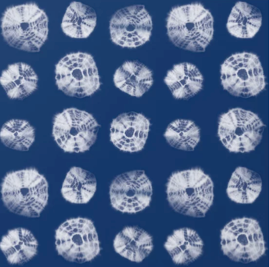Quite early on in our travels with Samarkand Design we came across a Dye Master in Sanganer, just outside Jaipur, India who was practicing the art of Shibori – the ancient art of Japanese Tie Dye. I became quite fascinated in how this technique of a form of resist dying had travelled from Japan to India and in fact, all over the world.
In attempting to track the origins of a textile design there is a considerable debate – as is often the case. The earliest reference relates to a gift of “spotted cloth” from Queen Himiko to the Emperor of the Wei dynasty in 238CE recorded in a Chinese document. However the general consensus is that Shibori was developed in Japan starting in the mid 8th century and the earliest surviving examples can be found in the Todai-ji Buddhist temple in Nara – part of a collection donated by the Emperor Shomu upon his death. It was during the Edo Period in the 17th to 19th Centuries that this form of tie dying became popular with the masses in Japan as people from the lower classes were banned from wearing silk so they looked for alternatives.

The name 'shibori' is derived from the Japanese word "shiboru" meaning to wring, squeeze or press. And the main point of difference between shibori and ordinary tie dye is that it requires the use of thread to create the patterns as opposed to just literally tying the cloth. Shibori is also distinguished by the use of only one colour. Originally only indigo was used as the dye but modern shibori can be made using any single colour – either from natural plant based dyes or pigment.
There are six main Shibori techniques:
Itajame
When the fabric is folded using an accordion pleats both vertically and then horizontally. It is then squeezed between two block of wood creating a grid-like pattern from where only the edges of the folds are dyed.

Kanoko
Kanoko shibori is made by tying the fabric with either thread or in modern times with elastic bands over bunched or twisted fabric. This is what in the West would be most commonly recognized as Tie Dye and will most usually be used to create circular patterns

Arashi
Arashi (literally “storm’ in Japanese– or Pole shibori is made by diagonally wrapping the cloth around a pole, then scrunching it up whilst binding with string or thread. This method creates a pattern like rain.

Kumo
This process involves wrapping found objects such as rocks or stones – in fact any shape or size so creating an infinite variety of pattern.

Miura
Miura Shibori involves the process of looping and binding to create intricate designs where the maker plucks pieces of cloth using a hook and a needle.

Nui
Nui shibori is similar to Kanoko but is made by stitching the cloth using running stitch and tying by pulling the stich tight – as used in gathering. This is the method we use in dying the silk for our Shibori shades.



It is possible to make unlimited patterns using this method – and I was first inspired by the rippling sand on a beach in Goa and thought of recreating that on a fabric.

It has been quite a long and tortuous journey to achieve the end result – with quite a few misses along the way. However now our Shibori range is one of our most popular collection of lampshades. It is available in Indigo on cotton – and in silk in the colour of sand - this is called Alleppey,

A grey version called Ashvem

And pretty in pink - Marari

What makes these shades especially unique is we have kept the crinkles left by the close gathering and stitching used during the dying process – and this adds an extra layer of texture to the lampshade.
If you would like to know more about Shibori and and this amazing art form do get in touch and we will try and help.

1 comment
Where can I learn this art in Sydney Australia